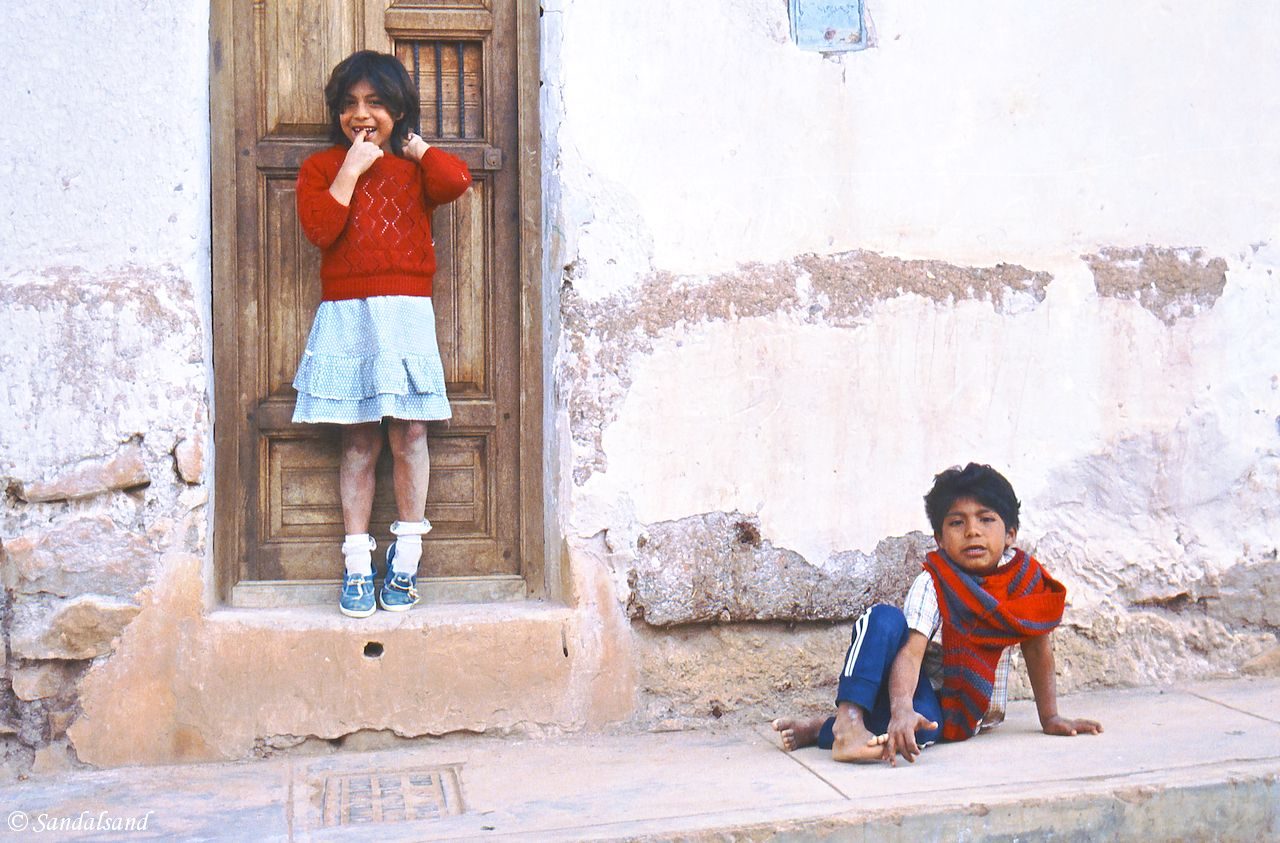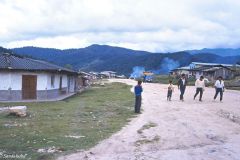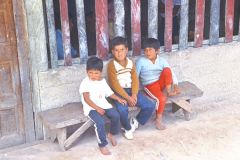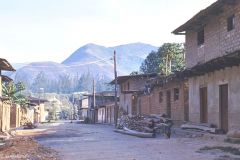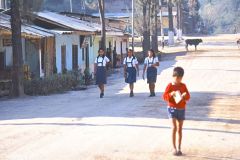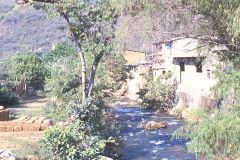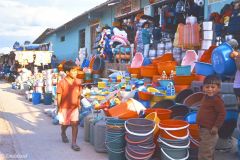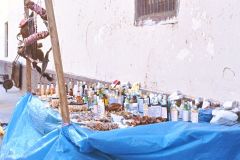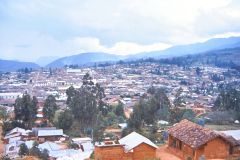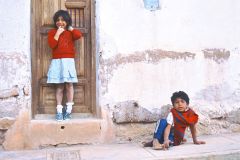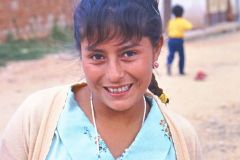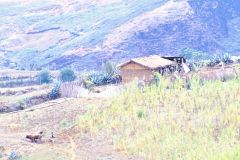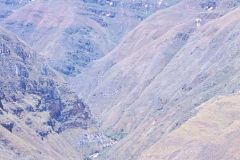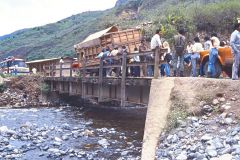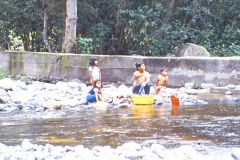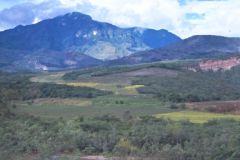The next week we continued across the Andes in northern Peru and prepared to move on up north to Quito, Ecuador. I also wrote a letter home.
This article is part of a travelogue from of a five month journey in 1987-1988 to several countries in South America: Brazil, Peru, Ecuador, Bolivia, Chile.
Monday 02.11.1987, Rioja – Pedro Ruiz
This is the day of departure. We started by exchanging money, cash, they would not accept traveller’s cheques. We then took a minibus on a poor road to Nuevo Cajamarca for an hour (25 intis, half a dollar). It is from that place we may find transportation onwards to Pedro Ruiz, a small village on a crossroads where we will be able to continue northwards or as we want to, turn south to Chachapoyas.
We waited a long time in Rioja and a little less in dirty and muddy Nuevo Cajamarca before a pick-up could take us and a number of others further on.
It was an amazing trip. The comfort was terrible; we had to stand in the dust cloud because the road was too lousy to allow us to sit for long periods of time on the wooden boards placed across the bed of the open truck.
.
What we saw along the road more than weighed up for the lacking comfort, even though we were mighty tired when we rolled into Pedro Ruiz after 7.5 hours and 175 intis (4.4 USD) poorer.
From Tarapoto to Rioja we had seen jungle vegetation all the time even though it was by far as flat as in the Amazon basin itself. Now we had been climbing higher and higher up in the mountains and the vegetation was becoming less dense. The landscape – the valleys and rivers – was grand. The buildings were, for a tourist, picturesque. There were small adobe cabins and poor people trying to make a living as best as they could.
In Pedro Ruiz we got ourselves a good hotel without a name, right by the bus stop. It cost us 120 intis (3 USD) for a double room and an ice-cold shower. It was the coldest I have ever tried, but it was very, very good.
Tuesday 03.11.1987, Pedro Ruiz – Chachapoyas
In the morning we walked around in Pedro Ruiz. The town seemed pleasant and was situated between high mountains, by a river and with trees scattered in between.
The minibus (micro) to Chachapoyas was slow before it finally set off. They run probably every hour on the hour and take two hours for the cost of 40 intis (a dollar). We had views of fine scenery along a river bed.
We stepped out of the bus on the plaza in Chachapoyas after showing our IDs at the “entrance” to town. The Guardia Civil guy asked for our passports and we should him our student ISIC cards. It worked well, as it had done before.
- Hotel Amazonas. It is situated on the Plaza. 100 intis (2.5 USD) for the “honeymoon suite” and finally double bed again. Alright place with bath in the room. Possible map.
We went for a walk of town and found it quite interesting. We met two Dutch people in a restaurant as we were busy with our diaries. They had been on a film expedition to find archeologically interesting things to make a film about. They were going to sell it to Dutch television.
Tonight we had pizza. It was not baked enough but two begging children ate the remains. They were the first we had experienced at a table, but probably not the last. The Callao Pilsen beer is good and I can feel the effect after only two large bottles.
Wednesday 04.11.1987, Chachapoyas
After breakfast we changed hotels. The water was too cold for showering.
- Hostal Kuélap. Not far from the tourist information office on the Plaza de Armas. It cost us 150 intis (3.7 USD) for a double bed, with private shower and hot water. Alright place. Possible map.
I had contracted a loose belly so we relaxed for some time in the room before leaving for the tourist office and a man who spoke understandable Spanish. We were given a brochure and a warning that it would be difficult to go to Celendin before next Tuesday. That journey takes 15 hours.
Well, we will just have to see the positive aspects of the situation and take advantage of the opportunity to see the sights this region has to offer. We started by walking up a hill above the town and wandering about in the streets. It was interesting and the pleasant locals were even willing to let their photographs be taken.
.
Some actually asked for it. An extrovert young woman even wanted us to send her the pictures so we got her name and address. We’ll see.
We were halted by the PIP office by a police officer in civilian clothing holding a holstered gun in his hand. He wanted to register us and had his will. He was curt, but nice really.
We bought some postcards and bumped into the two Dutch guys who told us they had been waiting the entire day at the airport for a plane to Chiclayo. It never came and the next flight is on Monday. They will now have to settle for a bus.
We met a German guy as well. He spoke English with an almost parodic German accent and had a strong distaste for touristy places like Machu Picchu and for photography. Instead he draws and paints his impressions.
Thursday 05.11.1987, Chachapoyas
Today we went for a walk in a valley. We had in the beginning in mind taking a trip to Kuélap which is an old citadel on top of a 3,100 metre high mountain. But then it started to rain and it became a bit too late to go there.
The valley hike was really nice with pleasant buildings along a road, dry and open grasslands and deep ravines.
Tonight we went to a cinema to watch an American movie (Treason of the Falcon, or something like that). In this country they show subtitles in Spanish so we figured we would get a full benefit of the English sound. Oh no. The sound was murky and lousy so we had to rely on the text and our knowledge of Spanish. We managed.
Letter to my family (posted in Quito 11.11)
Chachapoyas, Peru, 5th of November 1987
Hello again,
I’m wondering how long this letter takes to get home to you. We have as a matter of fact ended up in a town in the mountains without the best communication channels with the outside world. We learned yesterday that there is probably no transportation to the next place in a week. So now we are stuck here trying to make the best out of it. Like writing a letter to you…
It is amazing that it is only two weeks since Manaus and the letter I sent then. At home it takes months to gather the impressions and experiences we experience here in a single day. So while lying under my bed quilts to heat up after being surprised by a cloudburst while we were out walking in the area, I will try to make a resume of the last fourteen days.
.
The flight to Tabatinga on the border between Peru, Brazil and Colombia was exciting. Dense, green jungle everywhere, only dispersed by brown coloured rivers winding like snakes through the vegetation. As I wrote in the postcard to AE we ended in Colombia a few days. That was a funny and different experience than Brazil.
We went to a local disco mostly playing Colombian music and serving local liquor. The dancing consists of small rapid feet movements and rolling of the bottom, while the drink has the flavour of anise.
I was told that some fishermen had caught a 30 metre long anaconda constrictor and where now trying to tie it better before some way or another killing it. I would guess that would be difficult considering its reported one metre in diameter. 30 metres sounds like a lot, but I have seen several skins 5-10 metres long myself.
The next flight brought us to Iquitos in the Peruvian Amazon. The town is without road connections to the outside world, so we had the choice of 3-4 days in a boat or a plane for little over a 100 NOK. We chose the latter. But before leaving we experienced a few things.
.
Every town has its plaza where people walk around and around to see and to be seen. One day we were sitting on a bench in one of Iquitos’ plazas watching life go by. Then a long, thin, fair-haired guy came up asking in our dialect: “I hear you’re from Stavanger”. What a surprise.
It turned out that he had been travelling through Central and South America a couple of years and had been in Iquitos for 8 months. Here he worked picking up tourists for trips into the jungle. He had heard of us from others, even though we had only stayed in town for a day or so. We had a long conversation about travelling in general and his journey in particular. We got a few tips.
Down at the Amazon River is the slum. The houses are built on tilts because in the rainy season it is only possible to get around by boat. We were now able to walk on dry land between the simple houses and see how people were living. It is sad to see someone living as poor as this. But they were nice and the children willingly let their pictures be taken. The market close to it was large, bad smelling and exciting.
.
When we were about to fly onwards we heard at the airport that our flight was cancelled. Our plane was instead going somewhere else in Peru. We then had to wait until next day before we without further problems or extra expenditures (apart from hotel) was able to fly with another airline. Situations like that are not unusual in the jungle or in the mountains here in Peru. Two Dutch people we met here in Chachapoyas yesterday sat all day at the airport without their plane arriving. The next plane is not until Monday, five days later.
In any case we managed to move on to a town named Tarapoto. It is situated in between jungle and mountains, that is to say that the flat Amazon jungle here stretches itself uphill. Tarapoto itself is not the most interesting place, but we went on a nice trip up in the mountain sides to a smaller town. Really nice.
It is actually split in two. The Mestizos live in a more “normal” township up on a ridge, while the Amerindian population keep downhill in their sundried earth and clay huts. What a contrast. We were allowed into one of the houses – very basic and poor. The town museum had a collection of full size dolls, tools and clothing from the life and costumes of the indigenous population.
.
The onwards journey eventually brought us to the inland town of Rioja. The mountains are gradually becoming more dominant and it is obvious that we are getting close to the Andes. The roads are in parts very bad.
We stayed several days in Rioja for the sole reason that we by coincidence bumped into a local teacher at 25 who spoke English. Through him we got in touch with several others and received tips for excursions. We visited a hot spring and it was lovely to lie in clean water with a temperature of around 40° C. Like a bathtub.
The teacher Humberto was an active guy; party politics, local radio and photographer for a regional monthly magazine. We were invited to the radio station an evening and all of a sudden we were placed in a studio for an interview. Then – directly on air – we were in Spanish asked to give an overview of Norway; politically, economically and socially. Well, we managed to mutter a satisfactory answer, with the help of Humberto, and we also added a remark on the conditions in Peru.
.
The editor of the monthly magazine concluded that he wanted foreign correspondents. That would increase popularity and the circulation of his magazine. We promised to write an introductory article in the next edition and return with more on later occasions.
They took our picture and wanted to put us on the front page. Peruvian newspapers and publications have pictures of pretty girls in bikinis on the front page. Bo was therefore asked, because of her blond beauty, to pose in shorts. As she has her principles she ended up with long pants, but all the same …
I have not since China met such crowds and attention as when we walked around the town’s plaza. Especially my girlfriend Bo was stared at. But people are nice.
One night there were some performances on a stage (back of a lorry) on the plaza. Local forces (with a lot of nervousness and confusion) were in charge of song and play. The show peaked when a teenager came on stage wearing dark sunglasses. He was going to rock! I’m certain that a spastic would have beaten him to the ground. I haven’t seen such a disastrous and ridiculous affair for years. People were just smiling at him.
.
We left Tarapoto on the back of a pick-up. They are the most common means of transportation between the small towns around here. The road was terrible, with a rough gravel surface, and I wonder how it would be like in the rainy season. The flat bed of the pick-up was equipped with wooden benches. They were impossible to sit on due to the way the driver drove and the condition of the road. We were jumping up and down, in a standing position, for 7-8 hours while the dust ate its way into backpacks, clothes, skin and hair.
This was the only means of transport apart for air. The scenery was however so great that it outweighed the hardship of the trip. We climbed longer and longer up in the mountain sides, becoming steeper and steeper. The jungle was replaced by more “normal” vegetation. Along the road lay scattered the adobe houses (dried clay) of the residents: Picturesque for us, probably hard for them.
In the evening we drove into a little town and checked into a cheap (10 NOK each), clean and good hotel. The shower was a shock. The water was so cold that we were almost covered by a thin layer of ice. But the dust had to come off. Brrr…
.
The next day we took a minibus, after some waiting to fill it up with passengers, to the district capital of Chachapoyas. Here we are as of my writing this. On Wednesday we learned that there is no bus to the next place on our “list” until next Tuesday. Therefore we had to settle down and prepare to make the days go by watching ruins and the like in the area. Today Friday (Nov. 6th) there was no transportation coming to take us to the starting point of our excursion, so we said what the h. and bought a bus ticket in the opposite direction than planned. Tomorrow we are off in a north-west direction to the coast and then directly north to Ecuador.
The loss is not that big after all. We miss a town but still get the journey across the Andes Mountains. I’m looking forward to it, and will write more when we get to Chiclayo on the coast. The road is reportedly bad so we will have to see what shape I’m in after 18 hours on a bus – a real bus this time.
Friday 06.11.1987, Chachapoyas
We lined up early on the camionete stop. We had an idea of going to Tingo and climb Kuélap from there. But there was no camionete showing up and when the clock ticked past nine we figured there would be little time to climb the fortress.
We therefore went up to the plaza where a bus company has its office. It has transport to Chiclayo. We are not willing to wait until Tuesday to get on to Cajamarca. The result was that we are going toChiclayo on an 18 hour bus trip for 240 intis (6 USD).
We spent the rest of the day relaxing; writing letters; and eating poultry on a pollería (Piu Piu). Poultry is better in these specialised places than in ordinary restaurants. Bo has unfortunately caught a cold. I hope it is not getting worse crossing the Andes.
Saturday 07.11.1987, Chachapoyas – Chiclayo
Yesterday I was living in the misconception that we were actually going to cross the Andes. Today I realised that we had actually been doing that climb and that Chachapoyas was situated right in the middle. Therefore I saw my illusions of high, sharp, snow-capped mountains vaporise.
On the other hand it was the most beautiful scenery we experienced. There were deep, narrow valleys with foaming rivers on the bottom, and steep, green coloured mountains towering above us. A number of small farms were clinging to the hillsides, all with banana trees around their shacks.
As the hours went by the landscape flattened and we entered a district of rice producers. The terraces stretched out over large areas. Then darkness fell upon us.
The road was rather poor but the big, dented bus of the Olana Company managed the bumps and dumps better than the camionetes. There was little sleep though.
Sunday 08.11.1987, Chiclayo
After 18 hours we arrived around five in the morning in Chiclayo. The bus driver could in our opinion have maintained a higher speed.
We waited in the bus garage until daylight to avoid the possibility of checking into a hotel paying for an extra night. We then walked into town and encountered serious trouble finding a hotel. Despite being a place with numerous establishments there was apparently no vacancy. We were possibly too early in the morning for receiving new guests, but that sounded strange. In the end we found a hotel and put our bags in a room and left while they were making the beds.
We had a good breakfast at Restaurante Roma. It was pretty cold this morning, we felt, despite the temperature not being less than 23 degrees.
- Hotel Gran Splendor. The standard does not live up to the name. We found the bed made, but the floor and bathroom had not been cleaned. There was clogged drains in both the wash basin and in the shower. Water was flooding all over. 210 intis (5.3 USD) for a double room “matrimonial”.
We slept until the afternoon, did some laundry and went out to eat. Bo had tired of Peruvian steaks and chicken so we had lasagne at Roma. Quite good but it took ages to get the bill.
This morning there was a long parade of pupils and bands up the main street to the plaza. We failed to get the reason.
The market close to our hotel is large and interesting.
Monday 09.11.1987, Chiclayo
Late last night I got furious over the clogged drains in the bathroom and called the reception. The sent a guy up with a suction pump and fixed it. We decided to change hotels anyway.
- Hostal Berlin. Here we paid 160 intis (4 USD) for two beds and a bathroom. Not an attractive place. Balta Street by the market. Rough map location.
We bought bus tickets to Tumbes at the border to Ecuador at the Express Nor Pacifico for 200 intis (5 USD). We are leaving tonight at nine.
I spent a lot of time finding a place selling batteries for my camera. I found one in the end.
Letter to my family (posted in Quito 11.11)
Chiclayo, Monday 9th of November 1987
This is the day of lost illusions and new expectations.
The illusions were that I thought that we on the bus trip would pass snow-capped mountain peaks and end up at the Pacific Ocean thereby crossing the South American continent. The expectations consist of us travelling to the border of Ecuador this evening and that we tomorrow morning will have reached the capital of Quito.
The bus trip was fine. This time we took a bigger bus which true enough was fairly battered, but managed the very poor road better than the pick-ups we had taken previously. Chachapoyas must have been right in the middle of the Andes because it did not last long before we started our descent to flatter landscapes (rice paddies everywhere). Before that we drove through narrow valleys with gushing rivers and huge green-coloured mountains. The views were impressive, despite the lack of snow.
.
Chiclayo does not lie on the coast, as I thought, but rather on a plain near the ocean. Thus we will have to wait for a while before we are able to see the Pacific Ocean. Well, well, one can still say that we now have travelled from the Atlantic Ocean to the Pacific Ocean.
Quito is by the way only a few kilometres south of the Equator. Therefore we figure that we later in the week, or even this weekend will have our pictures taken on the monument built directly on the line. Then we will have been both to the geographical centre point of South America (Cuiabá, Brazil) and on the Equator.
I Quito I guess there is a letter waiting from you. I’m waiting to send this letter until then, so that I can answer any questions etc. The plan is to stay in Ecuador two-three weeks before setting course to Southern Peru, Bolivia and Chile. We are not coming home for Christmas and New Year.
Tuesday 10.11.1987, Chiclayo – Tumbes – Quito
We arrived in Tumbes at 0530 in the morning after a rather sleepless night. The border control station did not open until eight so we sat down and waited. We had some breakfast as time passed and we exchanged some money with a guy. He claimed he was offering us a good rate at 10 dollars cash to 240 sucres.
We then left the place to cross the border into Ecuador. We had from the outset not included Ecuador in our plans but figure now that we will be staying there for two-three weeks.
The story continues in the Ecuador section…
Further reading
The next chapter: We crossed the border from Peru in the south and went straight to Quito. We immediately found Ecuador to be an exciting country and with a lovely capital.
Read the introduction to this journey
View a full screen map of the journey

